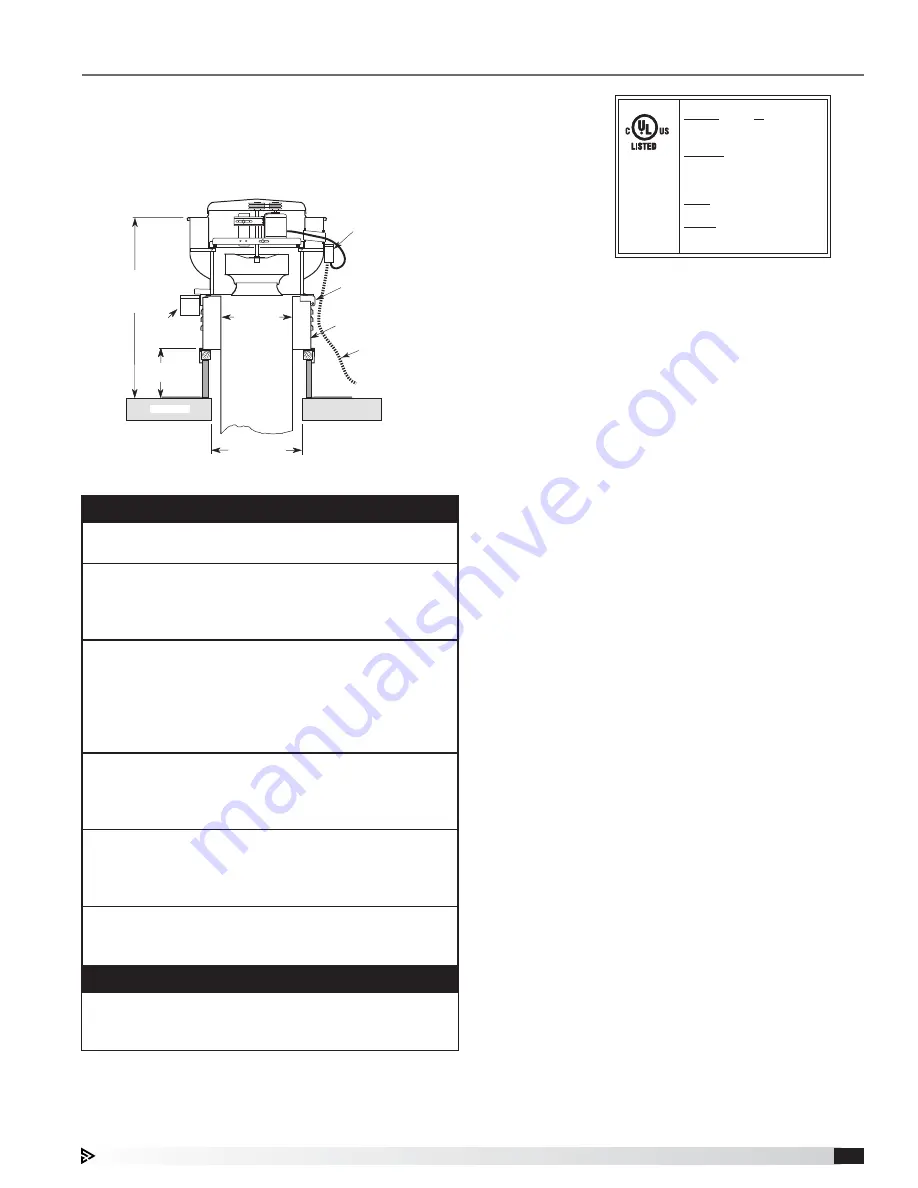
Steel Grease Fan
5
Commercial kitchen installations must comply with
NFPA 96. Check local and national codes for these
installations and consult local code authorities for other
specific requirements.
Perform steps 1-15: Typical Roof Mounting Installation.
Commercial Kitchen Installation
NEMA 3R
Disconnect
wired to
motor
through
breather tube
Recommended
Roof Opening
Roof Deck
Minimum 40 in.
(1016 mm)
Discharge
Height
8 in.
(203 mm)
minimum
Grease
Trap
Optional Vented
Curb Extension
Hinged Base
External Wiring
Liquid Tight
Flexible Conduit
(by others)
Welded Duct
(by others)
Minimum of
18 in.
(457 mm)
above roof deck
per NFPA
Figure 6 - Typical Roof Mounting Installation
461546
Power
Ventilator
Restaurant
Exhaust
Appliances
13G3
Maximum
Operating
Temperature
400°F
–Important–
ELECTRICAL
– If fan motor is NOT thermally protected, remote
overload protection must be installed having adequate rating as to
voltage, frequency, horsepower, and full load current per phase.
Where connected to a circuit protected by fuses, use time delay fuses.
For supply connection use wires rated for at least 90°C (194°F).
INSTALLATION
– When connecting electrical power to this fan,
do not restrict motor movement for possible future belt or wheel
adjustment.
Must be installed in accordance with the requirements to NFPA 96 or
must have minimum clearances of zero inches to non-combustibles,
3 inches to limited combustibles, 18 inches to combustibles.
CAUTION
– Mount with the lowest moving part at least 8 ft
PDERYHÀRRURUJUDGHOHYHO1RWUHTXLUHGRQURRIPRXQWHG
ventilators or duct mounted ventilators provided with belt guards.
ATTENTION
– Monter la pièce mobile la plus basse à au moins
2,5 m au-dessus du niveau du sol. Non requis pour les ventilateurs
montés sur un toit ou pour les ventilateurs montés sur gaine avec
protège-courroie.
Representation of
UL Listed
Power Ventilator
Restaurant
Exhaust
Appliances
label
Grease Trap Installation
The polypropylene grease trap is designed to collect
grease residue and avoid drainage onto roof surface.
Follow all local codes, as well as the National Fire
Protection Agency (NFPA) where applicable.
NFPA 96:
Upblast fans shall have a drain directed to a
readily accessible and visible grease receptacle not to
exceed 1 gal.
(3.8L)
Refer to Document 476370
- Grease Trap Installation,
Operation and Maintenance Manual for parts listing and
specific installation instructions.
Grease Trap Maintenance
Regular inspection of grease trap is recommended.
Depending on the amount of grease discharged through
the fan, the grease trap should be cleaned regularly to
ensure proper operation.
• Check grease absorber (if included) every month.
Replace grease absorber after every cleaning and/
or as needed between cleanings.
• Replacement grease absorbers (Part No. 476084)
can be ordered from your local representative.
IMPORTANT
The size of the duct must be equal to or larger than
the inlet opening of the fan.
To comply with NFPA 96, the fan discharge must be a
minimum of 40 in.
(1016 mm)
above the roof surface
and a minimum of 10 ft.
(3048 mm)
from any building
air intake.
Per NFPA 96, ductwork to an upblast discharge
exhaust fan must be constructed of and supported by
carbon steel not less than No. 16 MSG
(1.52 mm)
or
stainless steel not less than No. 18 MSG
(1.21 mm)
in
thickness. Duct must also extend a minimum of 18 in.
(457 mm)
above the roof surface.
Ensure that a minimum of 500 ft/min of air velocity
through the duct is maintained per NFPA 96, clause
8.2.1.1, 2014 edition and UL 762, Issue #7, clause 6.2,
October 14, 2013.
The following accessories may be required by NFPA
96 depending upon installation: Grease Trap and
Vented Curb. 8.2.1.1, 2014 edition and UL 762, Issue
#7, clause 6.2, October 14, 2013.
The following accessories may be required by NFPA
96 depending upon installation: Grease Trap and
Vented Curb.
IMPORTANT
Minimum duct velocities must be maintained in
kitchen exhaust applications. If a speed controller is
used, ensure compliance with all applicable codes.






























